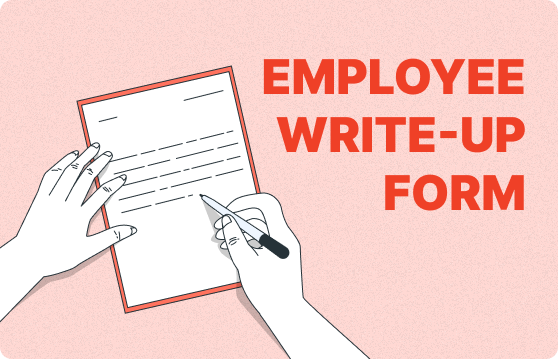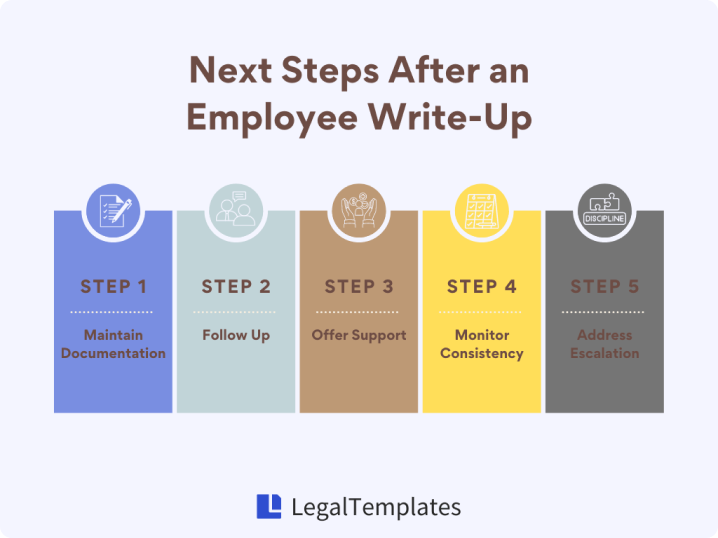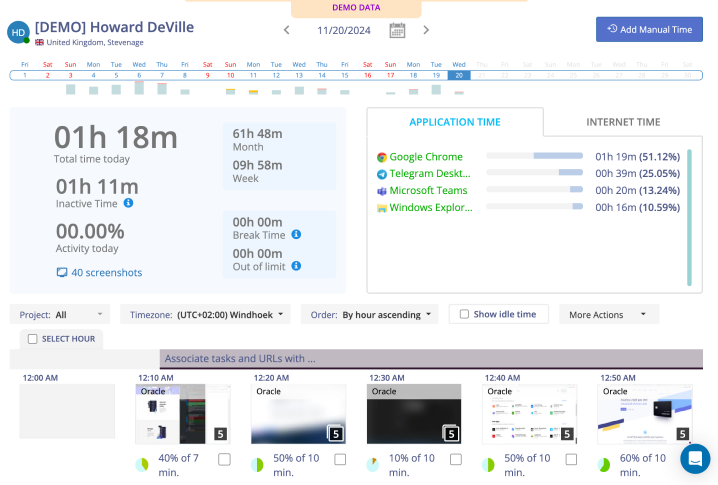Crafting an Effective Employee Write-Up Form: A Comprehensive Template & Guide

Managing employee performance and behavior is essential for a productive and harmonious workplace.
An employee write-up form is a key tool that helps employers document incidents, address misconduct, and ensure clarity in workplace expectations.
Properly crafted, this form serves as a record that supports consistent and fair employee management while protecting the company from potential legal issues.
In this guide, we’ll walk you through everything you need to know about creating an effective employee write-up form, including its key components, best practices, and practical examples.
What Is an Employee Write-Up Form?
An employee write-up form is a formal document used by employers to address and document instances of employee misconduct, performance issues, or policy violations.
It serves as an official record detailing the nature of the incident, the actions taken, and any corrective measures or consequences imposed.
The form typically includes key information such as the employee’s details, a description of the incident, relevant company policies violated, and expected future conduct.
Employee write-up forms play a critical role in maintaining workplace standards, ensuring clear communication, and supporting fair disciplinary processes.
They provide a transparent way to manage employee behavior while protecting the company from potential legal disputes by creating a written record of events and actions taken.
Importance of Employee Write-Ups
Employee write-ups are crucial for maintaining workplace discipline and ensuring clarity in communication. They provide a structured way to address issues, helping both employees and employers stay accountable.
Write-ups document incidents formally, offering protection during disputes or legal proceedings. They also set clear performance standards, promote fairness, and encourage professional development through constructive feedback.
When Should You Use Employee Write-Up Forms?
Use employee write-up forms when an employee’s behavior or performance fails to meet company expectations, including:
- Policy Violations: When company rules or codes of conduct are broken.
- Performance Issues: If employees consistently fail to meet performance goals.
- Attendance Problems: For chronic absenteeism or tardiness.
- Behavioral Misconduct: Including insubordination, harassment, or disruptive conduct.
- Failure to Improve: When prior verbal warnings have not led to improvement.
Timely use of write-ups helps prevent minor issues from escalating into larger problems.

Maximize productivity of your business
Track employee productivity and simplify work with them
Employee Write-Up Form Best Practices
Employee write-ups are an important part of managing performance and addressing behavioral issues in the workplace.
These forms document incidents, outline areas for improvement, and help set expectations for future behavior.
However, to ensure their effectiveness and fairness, it’s essential to follow best practices when creating and maintaining these forms.
1. Keep it Confidential and Professional
Confidentiality is crucial when handling employee write-ups. These documents should be shared only with the appropriate parties involved, such as HR or the direct supervisor, and must be stored in a secure manner. Distributing the write-up outside the necessary channels can damage trust and morale within the team. Additionally, write-ups should always maintain a professional tone. Avoid any language that could be perceived as judgmental or discriminatory, and focus solely on the facts and behavior in question.
2. Use Clear and Objective Language
Write-ups should be as clear and objective as possible. Avoid ambiguous language or subjective interpretations of the situation. Instead, describe what specifically happened, when it occurred, and how it impacted the workplace. Using facts and clear examples will reduce the potential for misunderstanding or conflict later on. This helps ensure that the employee fully understands the issue and what needs to be done to improve.
3. Align with Company Policies
Every organization has its own set of rules and policies that employees are expected to follow. When writing up an employee, make sure to reference the specific policies that were violated. Aligning the write-up with company guidelines ensures that all employees are held to the same standards and that disciplinary actions are consistent. It also provides a clear basis for corrective action and avoids accusations of bias or unfair treatment.
4. Use a Consistent Format
Consistency is key when handling employee write-ups. Using a standardized format for all write-ups ensures that they are easily understood and comparable. This consistency also reduces the potential for errors or omissions that could impact the outcome of the situation. Your format should include sections for the date, incident description, violation of policy, and the steps taken to address the issue. This approach not only improves clarity but also helps to track employee progress over time.

Key Elements of an Employee Write-Up Form
To create an effective employee write-up form, include the following components:
Practical Employee Write-Up Examples
Example 1: Employee Complaint Form
- Description of Issue: Document grievances or complaints filed against an employee.
- Policy Referenced: Company policy on workplace conduct.
- Corrective Action: Investigation and possible mediation.
- Employee’s Response: Employee provides their perspective on the issue.
- Follow-Up Date: Scheduled after the investigation concludes.
- Supervisor Signature: Required for acknowledgment.
- Employee Signature: Confirms receipt of the complaint.
Example 2: Employee Counseling Form
- Description of Issue: Used for performance improvement discussions.
- Policy Referenced: Performance evaluation standards.
- Corrective Action: Set clear improvement goals and timelines.
- Employee’s Response: Employee acknowledges goals and agrees to improvements.
- Follow-Up Date: Review set within 30 to 60 days.
- Supervisor Signature: Confirms discussion.
- Employee Signature: Indicates agreement to action plan.
Example 3: Employee Disciplinary Action
- Description of Issue: Records disciplinary actions due to serious misconduct.
- Policy Referenced: Company code of conduct or specific policy violated.
- Corrective Action: Formal warning or suspension, if necessary.
- Employee’s Response: Opportunity to present a defense or explanation.
- Follow-Up Date: Review after corrective action period ends.
- Supervisor Signature: Confirms action taken.
- Employee Signature: Acknowledges receipt and understanding.
Example 4: Employee Reprimand Form
- Description of Issue: Issued for formal warnings about misconduct.
- Policy Referenced: Relevant workplace behavior policy.
- Corrective Action: Warning issued with clear improvement expectations.
- Employee’s Response: Employee may respond or dispute the reprimand.
- Follow-Up Date: Evaluation after a specified monitoring period.
- Supervisor Signature: Confirms issuance of reprimand.
- Employee Signature: Acknowledges receipt and awareness of consequences.
Automated Employee Management in a Single Place
Managing employee performance, including documenting write-ups, can be a complex task for HR teams and managers.
With the increasing demands on HR departments, automated employee management tools offer a streamlined way to handle employee issues in one centralized system.
These tools can automate the documentation of performance issues, track employee progress, and ensure compliance with company policies.
With automated systems, HR can efficiently monitor and address employee behavior and performance, while also maintaining a high level of confidentiality and accuracy in the process.
One tool that can simplify these challenges is Monitask. It’s designed to take the complexity out of managing employee performance by automating tasks like tracking progress, and ensuring compliance with company policies. The platform makes it easy to spot patterns in employee performance and take action when needed.
By using Monitask, HR teams and managers can focus more on supporting their employees and less on the paperwork. It’s not just about solving problems — it’s about creating a smoother, more efficient workflow for everyone involved.

Conclusion
Employee write-ups are a vital part of maintaining a productive, respectful, and compliant workplace.
When used properly, they help address performance or behavioral issues while providing employees with clear expectations for improvement.
By adhering to best practices such as maintaining confidentiality, using clear and objective language, aligning with company policies, and following a consistent format, organizations can ensure that the process remains fair, transparent, and effective.
Moreover, the integration of automated employee management tools simplifies the process by centralizing documentation, tracking progress, and ensuring compliance.
By combining these best practices with technology, businesses can foster a culture of accountability, improvement, and fairness, ultimately leading to a more positive work environment for all employees.
Understanding the key components of an employee write-up and the common questions surrounding them will help both HR teams and managers navigate the process with confidence and ensure that all employees are treated consistently and respectfully.
– The Monitask Team
Frequently Asked Questions
How to Write an Employee Write-Up Form?
Writing an employee write-up involves detailing the incident or behavior in question, the specific policies violated, and the corrective actions that will be taken. Start by identifying the problem clearly, using factual information and objective language. Include the date, time, and any supporting evidence such as emails, reports, or witness statements. Outline the expectations moving forward and the potential consequences if the behavior continues. Make sure the employee signs the document, acknowledging their understanding of the write-up.
Does HR Do Write-Ups?
While HR may be involved in the process, particularly when the issue escalates or for final write-ups, employee write-ups are typically initiated by the employee’s direct supervisor or manager. HR can assist in the process by ensuring that the write-up follows company policies, offering advice on best practices, and maintaining documentation of the write-up in the employee’s file.
What is a Final Write-Up for an Employee?
A final write-up is typically the last step in a progressive discipline process. It is given after previous attempts to address performance or behavioral issues have failed. A final write-up usually indicates that further violations or failures to improve will result in termination. This document serves as a formal warning and is often included in the employee’s permanent file as a record of the final step before more serious consequences are considered.



